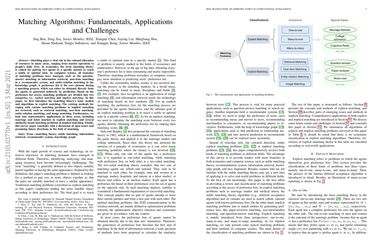Matching Algorithms: Fundamentals, Applications and Challenges
Matching plays a vital role in the rational allocation of resources in many areas, ranging from market operation to people's daily lives. In economics, the term matching theory is coined for pairing two agents in a specific market to reach a stable or optimal state. In computer science, all branches of matching problems have emerged, such as the question-answer matching in information retrieval, user-item matching in a recommender system, and entity-relation matching in the knowledge graph. A preference list is the core element during a matching process, which can either be obtained directly from the agents or generated indirectly by prediction. Based on the preference list access, matching problems are divided into two categories, i.e., explicit matching and implicit matching. In this paper, we first introduce the matching theory's basic models and algorithms in explicit matching. The existing methods for coping with various matching problems in implicit matching are reviewed, such as retrieval matching, user-item matching, entity-relation matching, and image matching. Furthermore, we look into representative applications in these areas, including marriage and labor markets in explicit matching and several similarity-based matching problems in implicit matching. Finally, this survey paper concludes with a discussion of open issues and promising future directions in the field of matching.
PDF Abstract